Vera and Donald Blinken Open Society Archives
“Do Friends Come to Visit with Tanks?” – Reactions to the 1968 Invasion of Czechoslovakia, 55 Years Later
Fifty-five years ago today, five Soviet-led Warsaw Pact countries invaded Czechoslovakia to put an end to the Prague Spring reform attempts led by Alexander Dubček. Operation Danube, the largest military maneuver ever undertaken by the Warsaw Pact, was also the first major foreign “intervention” by the Soviet Union since its tanks had crushed the Hungarian Uprising in 1956. Documents in the Blinken OSA Archivum’s archival series on Non-Ruling Communist Parties reveal that in the intervening 12 years, a number of key lessons had been learned, both East and West.
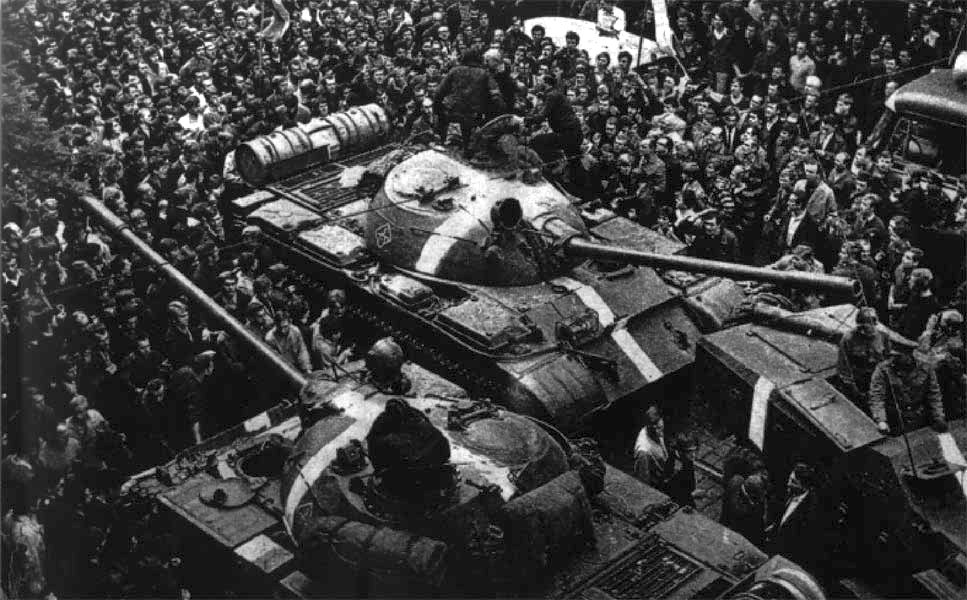 Crowd of protesters surrounding Soviet tanks during the first days of the invasion.
Crowd of protesters surrounding Soviet tanks during the first days of the invasion.
(Photo: Wikimedia Commons)
Invasions of other countries needed stronger, if not multiple pretexts and more actors on the stage, but most of all better PR. And as Cold War relations between the Kremlin and Western European Communist parties slowly degraded over time, the Western comrades had to find new ways to account for egregious foreign policy maneuvers in the name of friendship and cooperation.
Prague Spring, Prague Fall
Perhaps the last attempt at a Socialist utopia in Europe, Dubček’s proposals for “Socialism with a human face” were a relatively late but bold set of de-Stalinization policies, including freedom of speech and movement, the abolition of censorship, curbs on secret police powers, federalization, and guided economic reforms. All this was to be implemented under the direction of the Czechoslovak Communist Party (KSČ) while carefully maintaining good relations with the Soviet Union: the 14th Party Congress was expected to enshrine this new, improved version of Socialist Democracy in the constitution on September 9. Yet, one consequence of this “new system of the political management of society” was the rapid formation of civil society organizations and political parties, which worried the Party leadership not only in Prague and Bratislava, but also in Warsaw, East Berlin, and Moscow.
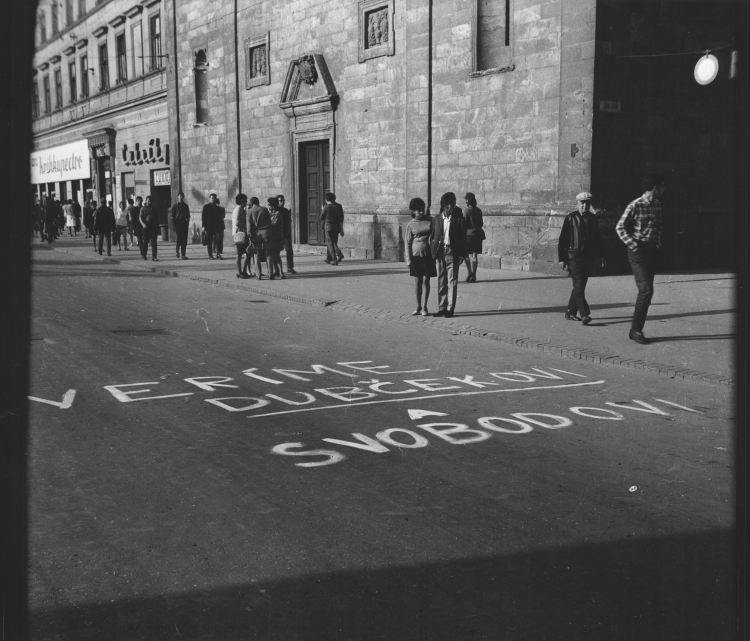 “We trust Dubček and Svodoba”
“We trust Dubček and Svodoba”
(HU OSA 391 Photographs of Gabriel Bodnar on the 1968 invasion of Kosice)
That same spring, Polish security forces were busy crushing student unrest, the French authorities were attempting to suppress running battles in Paris and national strikes, and the assassination of Martin Luther King galvanized broad anti-Vietnam War protests in the US. Meanwhile in Moscow, Yuri Andropov, former Soviet ambassador to Hungary 1954–1957 and then head of the KGB, was working together with Defense Minister Andrei Grechko on the “concrete military measures” that would become Operation Danube once the decision to invade Czechoslovakia was taken on August 18. The Soviets knew that the US was preoccupied with its disastrous crusade in Vietnam and would not, in any case, do anything to interfere with its “zone of influence,” according to the Cold War gentleman’s agreement in place since Soviet tanks put an end to the Berlin uprising of 1953.
Nevertheless, the Soviet invasion of Hungary in 1956 had been a watershed moment for the international Communist movement. Western Communists tore up their Party membership cards in droves, no longer able to deny or stomach the lies told on behalf of “tyranny and oppression masquerading as Socialism” or the “smokescreen of smears and irrelevancies thrown up by the present leaders of the Communist Party.” In the words of Pete Fryer, the British correspondent whose reports from Budapest were rejected by the Daily Worker, “the Stalinists put their faith in T-54 tanks and a four-day bombardment of Budapest; they support the export of Socialism in high-explosive form; I preferred and I still prefer to put my faith in the Hungarian people.” Those who remained in the Party and justified the invasions of Hungary and Czechoslovakia were nicknamed “tankies,” in other words dogmatic followers of the Kremlin line who believed that political problems are best solved by tanks.
In 1968 however, while the ageing tankies in the West could be counted on to display loyalty, better PR was required in the attempt to win over international public opinion.
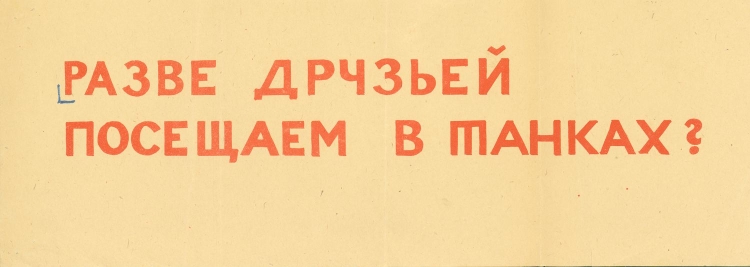 “Do friends come to visit with tanks?” Leaflet from 1968.
“Do friends come to visit with tanks?” Leaflet from 1968.
(HU OSA 300-30-14 Records of RFE/RL, Czechoslovak Unit, Collection of Documents on 1968)
In the early hours of August 21, a flight from Moscow carrying over 100 GRU Spetsnaz agents requested an emergency landing at Prague airport, claiming engine failure. Once on the tarmac, the GRU secured the facilities for the arrival of airborne forces, at the same time as Soviet, East German, Hungarian, Polish, and Bulgarian troops crossed the borders. The Czechoslovak armed forces were confined to barracks and one hour later, after broadcasting an appeal for calm, Radio Prague went off air.
More tricks were afoot. Two hours later, the Soviet news agency TASS cited a written plea from Czechoslovak Party and state officials requesting “urgent aid including the aid with armed forces” to neutralize the “counterrevolutionary” threat “in collusion with foreign forces hostile to Socialism.” The letter in question—which only came to light in 1990—had in fact been written by five hardline members of the Czechoslovak Praesidium in mid-July at a secret meeting mediated by the ambitious Ukrainian Communist Petro Shelest and hosted by János Kádár at his Lake Balaton villa.
Nor was there any shortage of conspiracy theories in circulation. The East German press claimed that American soldiers and tanks on the film set of the Hollywood feature The Bridge At Remagen being shot in the town of Davle, south of Prague, were “merely a cover-up for CIA and American intervention in Czech political affairs.” Neues Deutschland also insisted that a cabal of “intellectuals, writers, artists, economists, sociologists, and others” had collaborated with imperialists abroad to spread “petit-bourgeois nationalist ideology,” at the same time as lecturing skeptical Western comrades and overpowering domestic opposition to the invasion. According to the GDR’s theorists, “fraternal assistance” in the form of 500,000 troops was not incompatible with a Marxist-Leninist approach to safeguarding the independence of a Socialist state.
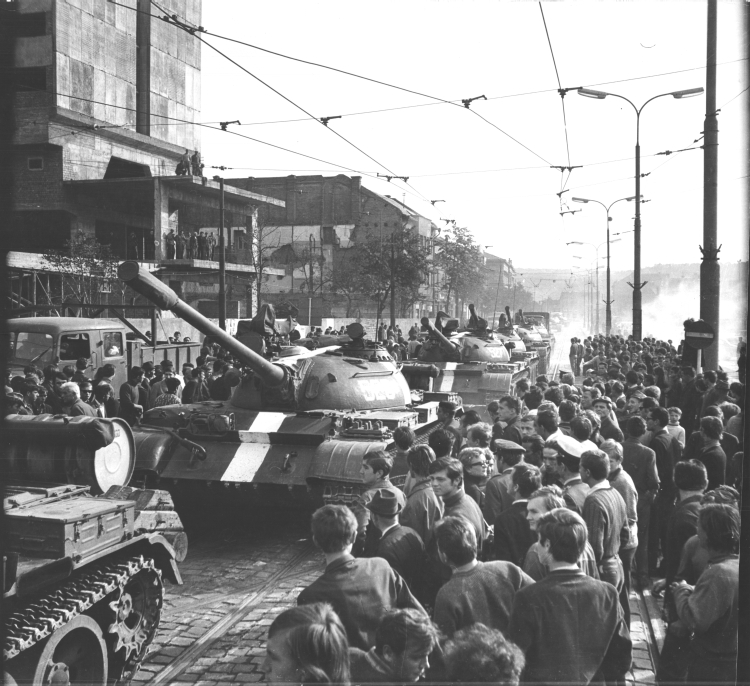 (HU OSA 391 Photographs of Gabriel Bodnar on the 1968 invasion of Kosice)
(HU OSA 391 Photographs of Gabriel Bodnar on the 1968 invasion of Kosice)
In Hungarian media meanwhile, emphasis was placed on the “spontaneous” deluge of letters and telegrams from the public expressing support for the necessary and correct response “in the interests of both the Socialist achievements of the fraternal Czechoslovak people and of European peace.” However, RFE/RL later picked up on an unsigned letter in the October 27 edition of Magyarország (Hungary), in which the author acknowledged that the Warsaw Pact troops were not welcome in Czechoslovakia.
Responses from the West – the Brits
In 1956, the Communist Party of Great Britain (CPGB) leadership had wholeheartedly adopted the official line supporting Soviet “assistance” to ensure that Capitalism and Fascism would not be restored in Hungary. The Party lost around a third of its membership—including most of the intellectuals—as a result of its meltdown over Khrushchev’s Secret Speech, its hardline pro-Kremlin position on Hungary, and its failure to allow internal debate.
In 1968 however, the Brits were one of the first Western parties to condemn the invasion of Czechoslovakia. The hardline, “tankie” wing of the Party—who labelled criticism of the invasion as “opportunism”—was now in the minority.
Disappointed that no evidence of the Czechoslovak request for intervention was forthcoming, the leadership under John Gollan cited the “cardinal principle of Communism,” that each country is “sovereign, decides its own policy, and is not subject to interference from other parties.” However, this new stance was coupled with a defense of the USSR and also the identification of the real enemy: “We need the utmost unity of all progressive forces, all Socialist states, and the fullest cooperation between the Communist Party of the Soviet Union and all other Communist parties, in order to defeat the aims of West German imperialism and end US aggression in Viet Nam.” In other words, Western powers, including NATO, were using the crisis to “escalate” the Cold War with the Soviet Union and its allies, and making political capital out of the invasion.
Allez Les Rouges
In comparison, the French Communist Party (Parti communiste français, PCF) was much larger than the British, and more consistently Stalinist. Marking the ninth anniversary of 1956, the PCF daily paper L’Humanité declared that the Budapest uprising had been a “putsch” designed to impose Fascism, which, if only for a few days, “gave hope back to the princes who had maintained Hungary in a semi-feudal state before the war.” Exactly one year later, in 1966, the same paper praised Hungary for its “successful establishment of national unity.”
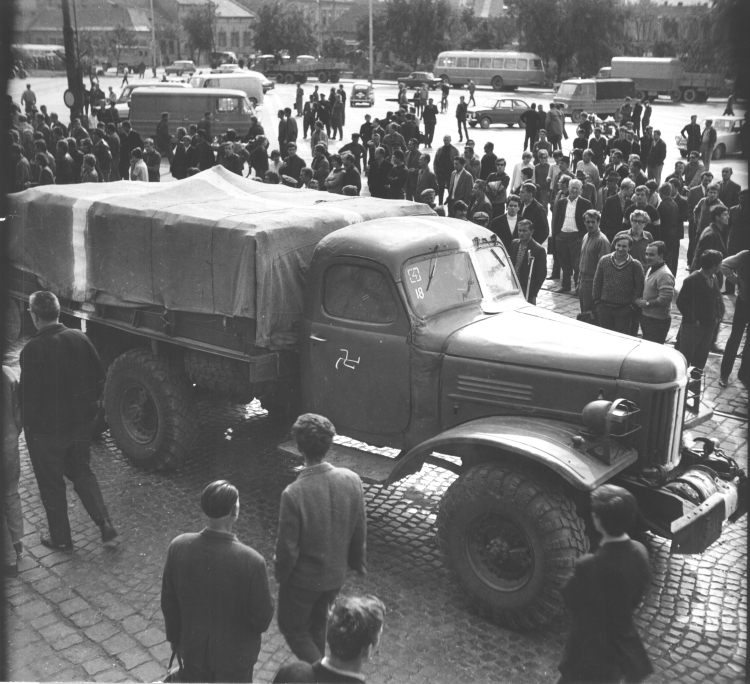 (HU OSA 391 Photographs of Gabriel Bodnar on the 1968 invasion of Kosice)
(HU OSA 391 Photographs of Gabriel Bodnar on the 1968 invasion of Kosice)
In mid-July 1968, PCF General Secretary Waldeck Rochet visited Dubček in Prague with an urgent request to revoke the Prague Spring reforms and reestablish full CP control as the only way to avoid military intervention. Two weeks later, Rochet visited Moscow, where he was apparently reassured that no invasion was planned. L’Humanité emphasized the dangers of anti-Soviet feelings in Czechoslovakia, and even named “Polish instigators” as part of the problem: “A sometimes harmful influence can result, especially since the reactionary circles of the emigration, solidly installed in certain capitals, including Paris, and powerfully supported by international forces hostile to Socialism, profit from this to promote subversion or corruption.”
Once the invasion had taken place, the PCF declared it a violation of Communist principles, although for most on the French Left, events in Central Europe were of little interest compared to the upheavals at home, or the glamour of Latin American rebels, such as Che Guevara or Fidel Castro.
Rome vs. Moscow
Of all the Western European CPs, the Italian Communist Party (Partito Comunista Italiano, PCI) had the greatest muscle and ideological autonomy. Palmiro Togliatti, who had led the Italian Party since 1927, did not oppose the 1956 Soviet invasion of Hungary, but laid the ideological ground for his successors to pivot entirely away from Moscow.
The PCI recognized the potential of the Prague Spring early on, and used its influence at various international Communist forums to promote Czechoslovak socialist democratization as a model for others to follow. In a show of vital support, General Secretary Luigi Longo visited Prague in May 1968, at a time when coercive pressure from Moscow, Warsaw, and East Berlin was already increasing. Lower-level contacts were also part of the Italian pro-reform stance: trade union delegates of the Italian General Confederation of Labour (CGIL) visited the ČKD and Auto Praga factories in the summer.
After August 21, the PCI did not hesitate in condemning the “neo-Stalinist blunder of the Eastern regimes,” and the Party daily L’Unità cited not only the principles governing relations between Soviet states but also the fundamental norms of international law. At the same time, on the domestic front, the Italian CP was building political alliances with non-Communists, and had calculated that subservience to Moscow was contrary to its interests. PCI publications highlighted the adverse effect of censorship in the Eastern Bloc: lacking basic information, citizens turned to foreign broadcasts, including Radio Free Europe, which was financed until 1971 by the CIA front organization the National Committee for a Free Europe. By the time martial law was declared in Poland in 1981, the PCI and its anti-interventionalist line was more of a burden than a benefit to Moscow.
The Vanishing Eyebrows
What the Communist Party of the Soviet Union (CPSU) really wanted from its Western subordinates was vocal support for its foreign policy maneuvers and ideological credentials. Somewhat surprised at the unfriendly reception they had received in Czechoslovakia, the next theoretical innovation was what became known as the Brezhnev Doctrine, a retroactive justification of the use of force when the threat to Socialism was “no longer merely a problem for that country’s people but a common problem, the concern of all Socialist countries.”
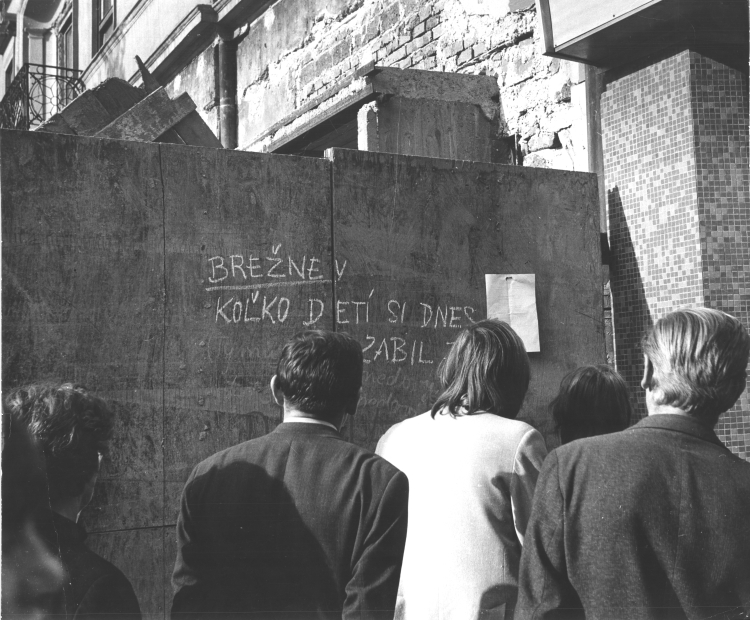 “Brezhnev, how many children did you kill today?”
“Brezhnev, how many children did you kill today?”
(HU OSA 391 Photographs of Gabriel Bodnar on the 1968 invasion of Kosice)
Applied to the invasions of Hungary, Czechoslovakia, and later Afghanistan in 1979—occupied in order to prevent occupation by anyone else—the Brezhnev Doctrine was later denied as a “fabrication of Western propaganda in 1986.” That same year, the Soviet Academy of Sciences specialist Evgenni Ambartsumov told the PCI L’Unità festival in Bologna that the 1968 invasion had been a “tragic error” but also inevitable, since the CPSU did not care about world opinion and regarded the Prague Spring as an “open danger for the internal Soviet situation.”
The Endless Hangover
Notwithstanding the collapse of the Soviet Union, many of the Cold War arguments advanced in defense of Kremlin-led aggression—the right to maintain order in its zone of influence, only the West can escalate, imperialism is always Western and never Eastern, domestic demand for outside intervention, Western meddling, or maybe none of it ever happened anyway—can still be seen in various guises today, with an unlikely collection of left-leaning academics and right-wing prime ministers blaming NATO and the US for Russia’s war on Ukraine.
On August 22, 1968, Kevin Devlin, a senior analyst at RFE/RL’s Communist Area Analysis Department, wrote that “the Russians have still to learn the full price they will have to pay—in political, diplomatic, and inter-party terms—for this short-term (and short-sighted) gain.” Fifty-five years on, that lesson has yet to be learned.

